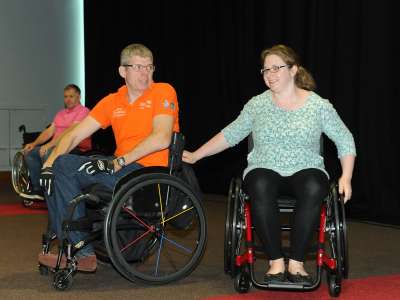
This year I attended the PMG Conference for the first time, made possible by the receipt of a bursary from PMG, and I decided that I would take the opportunity to book onto the pre-conference training running on the Monday.
This was the International Society of Wheelchair Professionals (ISWP) hybrid basic wheelchair training including a practical wheelchair skills workshop. The ISWP training consisted of online information and test to be completed in advance, the face-to-face training, followed by a repeat of the online test. There was then an option to complete the intermediate level online after passing this basic training.
The pre-training information and test were interesting, challenging you to think about wheelchair provision, not only from the point of view of what wheelchair services can provide in this country, but also about wheelchair provision around the world. I had some difficulties with the online system recording my completion of the pre-training elements (you can't attend the face-to-face training without having completed these); however this was quickly rectified with an email to Ffion at PMG who was able to help.
So, how was the training? Well firstly it was a smaller group than I had expected, with eight participants and two trainers (apparently there was space for 20 people). The small group did not at all detract from the training; in fact it made it easier to have in-depth conversations and to share knowledge and skills.
The training was described as basic, and this proved to be the case at first: we looked at what a wheelchair consists of, took measurements, filled out prescriptions, and checked pressure. However, I now believe that all wheelchair professionals would benefit from learning or consolidating these basic skills, and the course definitely ticked the box for that. There were hints and tips like using clipboards to measure against to get a true measurement, rather than just measuring between your hands; my favourite tip was to put a hand under one of the client’s feet on the footplate and the other under their thigh to see if the pressure was about the same on both hands.
That is where the basic bit of the course ended, because our discussions about the case studies, our own experiences, and advice from the trainers went into much more advanced detail. We discussed complex patients and clinical reasoning for deciding on wheelchair prescriptions. There was never a wrong answer, and it was interesting to hear where people differed in their opinions and why.
After a break for lunch we began the practical skills session led by trainers Michael Hipwell and Hannah Hunt from Back Up (a charity that supports people who have experienced a spinal injury). The session was an eye-opener for me in a number of ways. Firstly Michael and Hannah, both wheelchair users themselves, talked about their injuries and their chairs. They said it had taken five years of trial and error to know what they wanted and needed from their chair. This made me think about clients who have recent spinal injuries presenting at our service. They often want the highest specification chair with all the adaptations (understandably so, having just had a major life change and wanting to manage it as independently as possible) but is this actually what is needed? It might be better to prescribe a more basic lightweight chair initially, with an appointment to review what is going well or not so well after a couple of months. Do we need to be more honest and say that this process may take years to get the chair that is right for you?
The second thing that I took from the training was that, whilst you can get the lightest and highest specification chair on the market, if it’s not configured properly for you then it will be no easier to propel than a basic chair. This was emphasised when I found I was able to wheel more easily in a basic chair than one of the lightweight chairs which was much too high (seat height) and wide for me.
The third thing that I took from this part of the training is that propelling a chair is not only hard work, but takes a lot of courage at times. We were doing basic wheelchair skills such as up and down slopes, lifting the front wheels and going up and down curbs. Going towards an immovable object and knowing that you must time it exactly right to flip up your front wheels, otherwise you will hit it, is frightening. I tried to imagine how it would feel if I was reliant on my chair and hitting something which resulted in me being on the floor unable to get up. It would be terrifying. And that was before we got to the more complex skills like back wheel balancing down a slope, or going downstairs forwards whilst back wheel balancing!
It all made me think about how we provide clients with wheelchairs, seeing them for a short time and sending them off, happy in the knowledge that they have a suitable wheelchair. We have the basic assessment and prescription sorted, but do we think enough about the emotional and physical challenges, and the time it will take for clients to become comfortable, confident and proficient wheelchair users?
This training course has made me think much more about what I do and how I do it; I feel I will be a better clinician for having attended.
Photograph is of Jessica with Back Up trainer, Michael Hipwell, at the PMG/ISWP wheelchair training course, 15th July 2019






.jpg)



no comments
Add your comment...